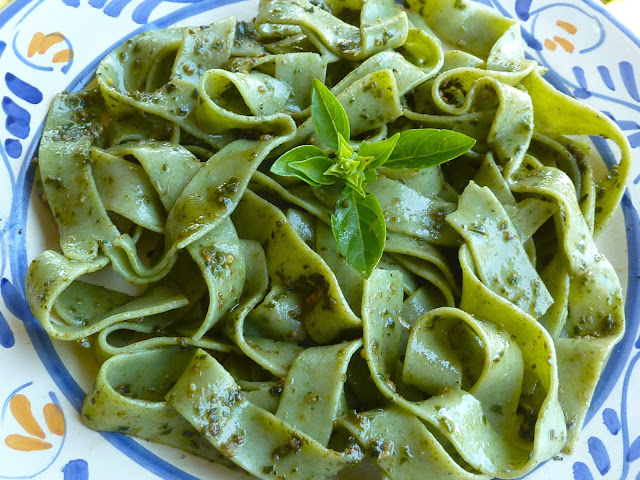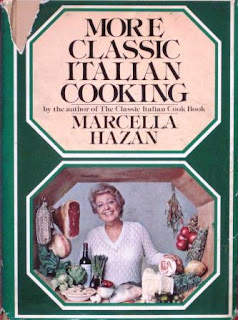Even before I tried it, I knew I'd love pesto. Basil has always been my favorite herb and the combination of garlic, olive oil, pine nuts and parmesan cheese with aromatic basil leaves sounded ambrosial. But growing up in a Mid-western meat and potatoes community in the 1950s, no one I knew had ever made it and it was not served in restaurants we patronized. Spaghetti and meat balls was the only pasta dish I was familiar with, and we didn't call it "pasta" until I went to Italy during my junior semester abroad. That was in Florence where pesto (a dish from its rival Genoa) was frowned upon. Tomato based pasta dishes prevailed.
Finally, in my early 30's in California I woke up to
PESTO. I had opened my bookstore Cookbook Corner, and paging through
The Classic Italian Cookbook by Marcella Hazan, published a few years earlier, I read this beautiful passage on page 139:
"If the definition of poetry allowed that it could be composed with the products of the field as well as with words, pesto would be in every anthology. Like much good poetry, pesto is made of simpe stuff. It is simply fresh basil, garlic, cheese, and olive oil hand ground into sauce. There is nothing more to it than that, but every spoonful is loaded with the magic fragrances if the Riviera.
The Genoese, who invented it, insist that authentic pesto cannot be made without their own small-leaved basil and a marble mortar. This is true and it isn't. It is true that Genoese basil is particularly fragrant, partly because of the soil but, even more important, because of the Mediterranean breezes that bathe it as it grows. It is also true that grinding the basil into the marble of the mortar somehow releases more of its flavor than other methods. But, with all this, pesto is such an inspired invention that it survives almost anything, including our minty, large-leafed basil and the electric blender."
 |
| My 1977 edition of the Classic Italian Cookbook |
The beauty of her prose, the clarity of her directions and the unfailing success of the finished dishes, have always endeared me to Marcella. And even though I know from personal experience— and many other sources— that she can be quite cranky in person, she is unsurpassed as a food writer. Being that her native language is Italian, and she didn't come to this country until her twenties when she married Victor Hazan, I suspect that he had a great deal to do with the polished and elegant prose in this and all her subsequent books. She certainly lavishes affection and praise on him in many of her dedications. In her
Classic Italian Cookbook she writes, "To Victor, my husband
con tutto il mio amore e profonda tenerezza."
 |
| Basil leaves rinsed, dried and ready to be transformed into pesto |
Shortly after I read Marcella's instructions for pesto in
The Classic Italian Cookbook, I set out to make my first batch. It sounded so easy: gather the famous four ingredients and grind them to a paste in a mortar with a pestle. I used my smallish French marble mortar and pestle and---
I began grinding basil leaves, olive oil and garlic cloves together. But it was useless. Oil splattered all over the counter, the leaves refused to form a paste and the garlic slid around the slippery sides of the mortar, refusing to emulsify. I was close to tears, grinding uselessly, then pounding angrily. I couldn't believe the mess I was making. Marcella was no help. So, then and there I left the kitchen and drove straight to my friend Louise's Berkeley kitchenware shop, Cookworks, and bought a Cuisinart food processor. I set it up at home and dumped the contents of the mortar into the bowl, turned it on and in only a few seconds a small miracle occurred. The basil, oil, garlic and pine nuts whirred effortlessly into a lovely smooth green paste.
 |
| Successfully blended pesto in my first Cuisinart |
I poured the unctuous green mixture into a bowl, added Parmesan cheese and admired the finished product. Never again did I attempt to grind pesto with a mortar and pestle, though by now I know that the secret to successful hand-grinding is a large mortar with a sturdy hardwood pestle. These items can be found in most Asian groceries and can also be used to grind Thai red and green curry pastes.
 |
| A bouquet of flowering basil leaves left over after making pesto |
The recipe is so simple I know it by heart, and only occasionally do I need to look it up in my book.
First I buy a beautiful, fragrant bunch of fresh organic basil at the farmers' market. Then I strip the leaves from the stems and immerse them in a large bowl of cold water. Almost always I find a scattering of dirt on the bottom of the bowl, so I feel rinsing is necessary. I towel dry the leaves, (the only tedious part of the operation,) and throw the stems in my greenbin. Then I measure two packed cups of leaves in a glass measuring cup, dump them in my newer Kitchern Aid food processor, add two chopped cloves of fresh garlic, two tablespoons of either walnuts or pine nuts, a pinch of sea salt, and one half cup of extra virgin olive oil. I then turn on the machine and grind the pesto for a few seconds until it appears smooth, sometimes adding a bit more oil, if it looks dry and moves sluggishly. I pour it out of the food processor into a clean bowl and make a second identical batch. When I've used most of my basil and my pesto is finished, I add one half cup of grated Parmegiano/Romano cheese and hold it until I make my pasta. When the pasta is almost cooked, Marcella directs us to add a small amount of pasta water and a few tablespoons of warm butter to enrich the pesto. I serve the pasta and allow each diner to add his own pesto and more grated cheese.
Buon Appetito
 |
| Fresh spinach fettuccine al pesto on an Italian plate |
FEATURED BOOKS

Marcella Hazan taught Italian cooking classes when she first came to New York from Italy, as a young bride. She then gathered her recipes from all over Italy and wrote them down to try to help American readers discover the happiness and beauty of the total Italian food experience. This effort resulted in
The Classic Italian Cookbook which was published by Alfred Knopf in 1973. The book sold well and took its place in many kitchens throughout America, including mine. But when she finished this beautifully written volume she regretted that "there were still so many wonderful dishes one could do!" The surprising success of the book made her realize that uncomplicated Italian home cooking was exactly what many people wanted. So she wrote
More Classic I
talian Cooking, which again was published by Knopf in 1978. I have a first edition signed by her when she visited my store in San Francisco on her book tour. I actually prefer this second volume. The recipes, gathered from nearly every province of Italy seem more creative, the ingredients more vibrant, and the results always superb.
For a sparkling example of Marcella's writing, go to the introduction of
The Classic Italian Cookbook and swoon over her poetic style. The section I recommend describes The Italian Art of Eating and begins, "
Not everyone in Italy may know how to cook, but nearly everyone knows how to eat. Eating in Italy is one more manifestation of the Italian's age-old gift for making art out of life."
In1992 her two books were gathered into one volume, entitled
Essentials of Classic Italian Cooking. They deleted some recipes and added fifty new ones. Wouldn't you know, they eliminated some of my favorites, so I'm happy to own the two originals. One deleted favorite is a recipe for pears cooked with custard and
cioccolato. Another is included but is difficult to find because the name has been changed. It's actually a pesto recipe,
Picagge col Pesto di Ricotta which inventively directs you to blend a small amount of fresh ricotta cheese into the finished pesto, lightening and refreshing the sauce. The ricotta pesto is then layered with al dente lasagne noodles to create an easy and spectacular dish. Or you can mix the concoction with a pasta of your choice. Both of these creations are from
More Classic Italian Cooking.
Also deleted is the inspiring introduction to
pesto in the
Classic Italian Cookbook, quoted above. Mrs Hazan does, however, have some new things to say about pesto, which are right on the mark:
"Pesto may have become more popular than is good for it. When I see what goes by that name, and what goes into it, and the bewildering variety of dishes it is slapped on, I wonder how many cooks can still claim acquaintance with pesto's original character and with the things it does best."
As for me, I'm sticking to the classic version of this culinary masterpiece. I don't want to risk displeasing Marcella, and why mess with perfection?







